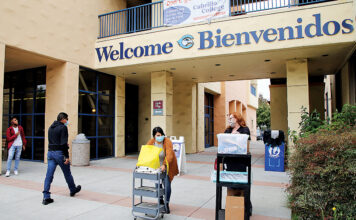Over the last few years the County has experienced significant flood events and damage that we are still working to repair. With climate change, severe events like these storm sets are expected to become more common as are the severity and length of droughts. One thing that is clear is that there is a significant cost, environmental and fiscal, to climate change. Locally, resiliency planning has already begun and we are looking at ways to protect critical infrastructure (including roads and utilities) to guard against everything from more severe storms to sea-level rise.
It’s a significant effort and as part of this effort the County developed a Climate Action Strategy. The Climate Action Strategy includes efforts by multiple departments to address greenhouse gas emissions reduction and preparation for the anticipated impacts of climate change. Every year, the Board of Supervisors and the Commission on the Environment receive reports on these efforts and provide input and focused direction on ways to address these challenges.
What have the recent reports shown?
The County uses a baseline year of 2005 to measure emissions reductions at County facilities throughout the community. In 2015 and 2016, the annual reports showed notable reductions in emissions compared to the baseline year. In 2016, for example, the County had reduced emissions from major facilities by 18 percent compared to the baseline year. In 2015, overall community emissions also decreased by 18 percent compared to the baseline year.
Why have there been reductions in emissions?
The Climate Action Plan builds on longstanding County policies to support green purchasing, fuel efficiency, and energy conservation, a Green IT policy and a goal to reduce reliance on fossil fuel in general. However, since the implementation of the Plan, the County has more aggressively sought to reduce emissions including significant investments of solar on County facilities, the establishment of Monterey Bay Community Power and changes in fleet vehicles. These changes have accelerated the rate of reduction of greenhouse gas emissions in the County. In the case of solar, the County has also reduced electric costs, saving taxpayer funds.
To further our efforts, the Commission on the Environment has been supporting efforts to prioritize strategies to prepare for the impacts of climate change. For example, how will we best plan to protect critical infrastructure? Vulnerable infrastructure includes transportation systems, buildings, communications, utilities, beaches and other amenities that support the community, tourism, agriculture and commercial activity.
As part of this, the County is working on updating the Local Hazard Mitigation Plan. This involves a vulnerability assessment that will identify the types and numbers of existing buildings, facilities, and infrastructure vulnerable to each hazard and the development of mitigation strategies and actions to reduce the effects of each hazard.
We know that more needs to be done.
In order to guide this effort, the Board of Supervisors recently approved the creation of a Climate Action Manager position. This position will be dedicated full-time to coordinating resiliency efforts between departments, creating strategies to address these growing challenges and also seeking funding from state and federal sources for resiliency efforts. These efforts are essential for protecting our infrastructure and other critical needs. Climate change will have significant impacts on fire and flood hazards, sea levels, drought, public health and agriculture. We all have a role in reducing emissions and the County’s Climate Action Strategy is part of those efforts.
As always, I appreciate hearing your thoughts. You are welcome to visit me during my open office hours in Aptos, Corralitos, Watsonville or Seascape or give me a call at 454-2200.











